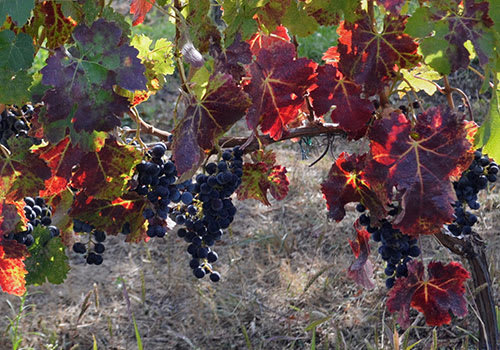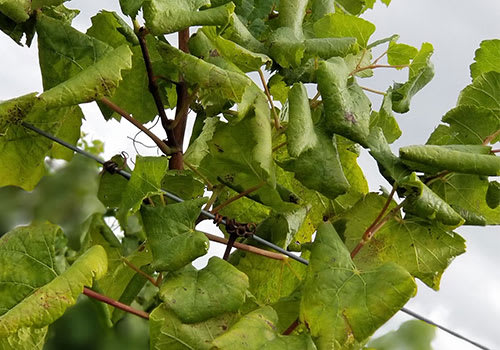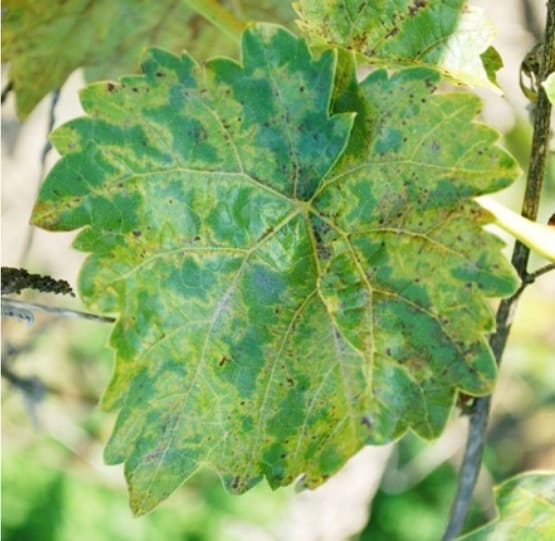These common grapevine viruses are present in grape-growing regions Canada. Learn more about the visual symptoms, how it spreads and control and management options.

Grapevine Red Blotch Disease
Grapevine Red Blotch Virus (GRBV)
Grapevine red blotch disease is caused by Grapevine Red Blotch Virus (GRBV). GRBV is known to infect all major wine grape varieties as well hybrids and table grapes. GRBV is known to be present in all grape growing regions of North America, as well as a few other grape growing regions around the world.
Visual Symptoms
- Red or purple blotches on leaves on mature leaves in red-fruited cultivars
- Yellowing or mild necrosis on the mature leaves in white-fruited cultivars
- Symptoms can be confused with Leafroll disease or potassium/magnesium deficiency
- Symptoms on hybrid cultivars are less apparent or show no clear symptoms
- Typically, symptoms start to appear after the véraison
- Uneven ripening of berries and thin clusters can be seen due to GRBV infection
- GRBV infection decreases the vine productivity and the life span of the vineyard
- Reduced yield and poor quality of grapes would result in significant economic losses
- Negatively impacts the sugar content in the fruit at maturity
How It Spreads
- Primary spread is by propagating the GRBV infected planting material
- Threecornered alfalfa hopper, Spissistilus festinus (Say) is a reported vector of GRBV in California and other possible insect vectors are suspected, and the research on identifying potential insect species is under progress in Canada
Control & Management Options
- Once the vine is infected, there is no cure for grapevine red blotch disease. Prevention is the best strategy to manage the spread
- Use of virus-free certified planting material is highly recommended
- Make sure both rootstock and scion wood material is tested for the virus
- Rogueing or removal of infected material is a good practice to reduce the incidence and spread of red blotch disease

Grapevine Leafroll Disease
Grapevine leafroll-associated viruses (GLRaV)
There are more than five different virus species that cause Grapevine leafroll disease (GLD) are known as “Grapevine leafroll-associated viruses (GLRaVs)”. The different species of GLRaVs are referred as GLRaV-1, -2, -3, -4 and -7. There are many variants of GLRaV-2, -3 and -4 that are known to be present that are associated with GLD. GLRaV-3 is the most common among the different species of GLRaVs and is known to be present in all grape growing regions of Canada.
Visual Symptoms
- Red or purple coloration on mature leaves with green veins in red-fruited cultivars
- Yellowing on the mature leaves in white-fruited cultivars
- Backward rolling of mature leaf margins commonly found in both white and red fruited cultivars
- Symptoms can be confused with grapevine red blotch disease or potassium/magnesium deficiency
- Symptoms are clearer on red-fruited wine grape cultivars
- Symptoms on hybrid cultivars are less apparent or show no clear symptoms
- Typically, symptoms start to appear after the véraison
- Uneven ripening of berries and thin clusters can be seen due to GLRaVs infection
- GLRaVs decreases the vine productivity and the life span of the vineyard
- Reduced yield and poor quality of grapes would result in significant economic losses
How It Spreads
- Primary spread is by propagating the GLRaVs infected planting material
- Some species of Mealybug and soft scale insects are known spread GLRaVs except for GLRaV-2
- There is no known insect vector reported for GLRaV-2
- Grape mealybug and European fruit lecanium scales are two known species reported to be present in Canada.
Control & Management Options
- Once the vine is infected, there is no cure for grapevine leafroll disease. Prevention is the best strategy to manage the spread
- Use of planting material from certified sources that is produced from virus-tested rootstock and scion material is highly recommended
- Controlling mealybugs and soft scale insect populations will also reduce the spread of GLD
- Rogueing or removal of infected material is a good practice to reduce the incidence and spread of GLD
Grapevine Pinot Gris Virus
Grapevine Pinot Gris Virus (GPGV)
Grapevine Pinot Gris Virus (GPGV) is proposed as a provisional new species belonging to the genus Trichovirus in the family Betaflexiviridae.
Visual Symptoms
- Chlorotic mottling and leaf deformation and reduced growth of infected vines are the common symptoms if infected with a symptomatic strain of GPGV.
- Symptoms are similar on both white and red fruited cultivars.
- Symptoms can be seen from early spring on leaves
- The asymptomatic stain of GPGV can be present but shows no symptoms
Control & Management Options
- Prevention is the best strategy to prevent the spread
- Use of planting material from certified sources that is produced from virus-tested rootstock and scion material is highly recommended
- Rogueing or removal of infected material is a good practice to reduce the incidence and spread of Grapevine Pinot Gris virus

Tomato Ringspot Virus
Tomato Ringspot Virus (ToRSV)
Tomato Ringspot Virus (ToRSV) is a single-stranded RNA virus transmitted primarily by nematodes, especially Xiphinema spp. The virus has a wide range of hosts, including grapevine, raspberries, tomatoes, and other perennial plants. Image credit: Dr. Marc Fuchs
Visual Symptoms
- Yellowing or molting leaves
- Ring-like patterns on leaves
- Leaf necrosis (brown/black spots where leaves are dying)
- Uneven leaf growth
- Reduced berry size and poor berry development
- Premature grape ripening, resulting in lower sugar content and poorer flavour
How it Spreads
- Nematode transmission: The most common method of ToRSV transmission is through nematodes, specifically the dagger nematodes (Xiphinema spp.). Nematodes feed on infected plant roots, acquire the virus, and then transmit it to healthy plants as they feed
- Contaminated plant material: ToRSV can be transmitted through infected grapevine cuttings or budwood used for propagation
Control & Management Options
- Prevention is the best strategy to prevent the spread
- Use of planting material from certified sources that is produced from virus-tested rootstock and scion material is highly recommended
- Thorough inspection and testing of planting material can help identify and eliminate infected plants
- Applying nematicides to the soil can help reduce nematode populations and limit virus spread
Information courtesy of:
Sudarsana Poojari
Principal Scientist, Grapevine Virology, Cool Climate Oenology and Viticulture Institute
Adjunct Professor, Department of Biological Sciences
Brock University |1812 Sir Isaac Brock Way | St. Catharines, ON L2S 3A1
